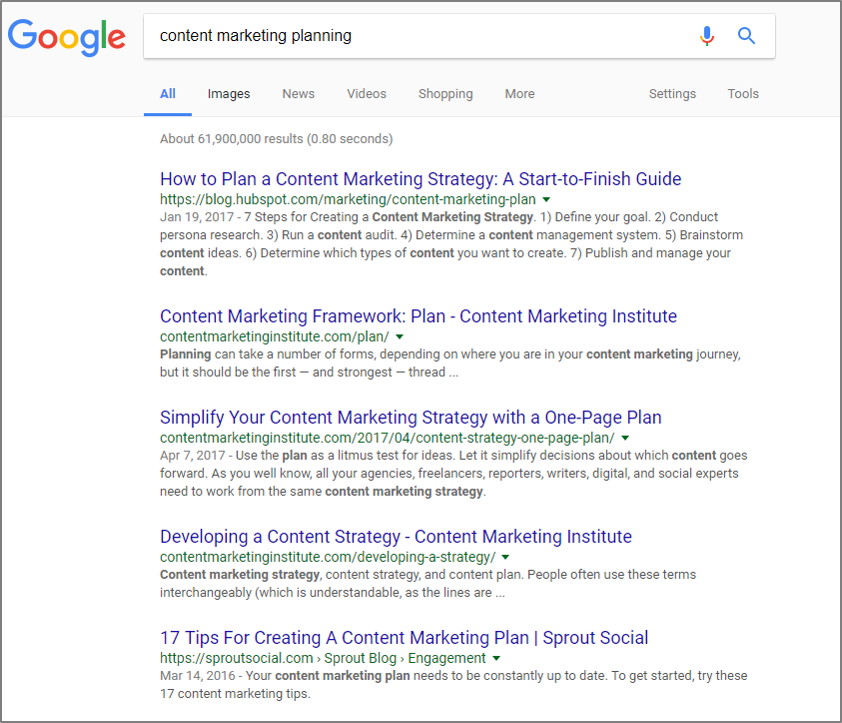Below are a handful of helpful research tactics you can use to make the most of your time and create a content plan that’s flush with solid topics. Let’s take the keyword topic “content marketing planning” as an example. My goal now is to craft a concept that will provide a better answer than what currently exists. When it comes to content planning, this data along with keyword topic and query suggestions, can help you identify low-hanging opportunities or further refine the other research you’ve already done. Building off my previous example of “content marketing planning,” I know that my incognito search revealed that “content marketing strategy” was a heavily-related keyword from a search intent standpoint. In my opinion, Google Search Console, formerly Google Webmaster Tools, is one of the most helpful SEO and content planning tools out there. But from a content planning perspective, Google Search Console allows you to see which queries actually caused your site’s content to appear in search results. Once you’ve discovered some of those burning questions, you can use the incognito search tip to understand what content already exists out there for that question, and determine how you can answer the question better and provide more value to searchers. And when it comes to crafting effective content, SEO needs to be part of the content marketing planning process if you want to drive results. Use these tips to help make it an easy and efficient part of the process.

When it comes to crafting compelling content that informs, engages and inspires action, seasoned B2B digital and content marketers know our content needs to captivate both humans and search engines to be effective. After all, 81% of B2B decision makers conduct research before reaching out to a vendor, so we know our content needs to meet them whenever and wherever they’re searching.
As a result, striking that “perfect balance” between SEO and user experience is a must—and that perfect balance is rooted in the content planning stage.
“SEO needs to be baked into the process early so that the optimization is as natural as possible,” Kevin Cotch, TopRank Marketing SEO analyst, says. “It can’t be treated as an afterthought. It’s not only more efficient to do your research up front, but it also enhances the content by helping you touch on the specific phrases your audience is using to search to solve their pain points or answer their questions.”
But there’s a little hitch—SEO research can be overwhelming for content creators. We’re often strapped for time and it’s easy to fall down a less-than-productive SEO rabbit hole. In addition, some of us may feel we don’t have the needed expertise or tools.
The good news is that you don’t need to fanciest tools or a dedicated background in SEO to craft great SEO-driven content. Below are a handful of helpful research tactics you can use to make the most of your time and create a content plan that’s flush with solid topics.
#1 – Perform incognito searches for your most important keywords.
Your team has likely developed a list of core keywords and topics that are incredibly important to your brand from a service and search standpoint. And you’ve likely begun to create content around those key topical areas and you’re seeing some movement in the SERPs. Naturally, your ultimate goal is to get your content to the top of Page 1 search results. But have you taken the time to dig in and draw insights from the content you’re hoping to dethrone?
Incognito searches using your priority keywords can help you uncover some of those important insights. An incognito search prevents your browser history or cache from impacting the results, allowing for a more accurate picture of search results. As my colleague Jesse Pickrain so eloquently said in one of my recent posts on finding B2B content marketing inspiration: “There’s gold in them thar SERPs.”
Once you’re served up with some results, spend about 10 to 15 minutes reviewing the content in the top three to five spots. Your goal should be to learn how the content is structured, identify the perceived value it provides your audience, the main pain points it addresses, and ultimately if you have the ability to create something better than what’s ranking at the top. In addition, take a peek at the “related searches” area so you can see other queries that match the search intent of your original search for more clarity and direction for planning your content.
Let’s take the keyword topic “content marketing planning” as an example. At first glance, I see the top results all offer frameworks or tactical guides.

As I dig in, I can see that four of the top five are all in-depth, long-form pieces, and the content is organized using a range of heading tags and bulleted sections to make it easy to scan. But I also notice that “content marketing planning” isn’t an exact keyword match, rather “content marketing strategy” is present in nearly all of the pieces.
In addition, I can see that the related searches have several variations of “content marketing strategy.” After clicking around in those results, I can see that a lot of the…
COMMENTS